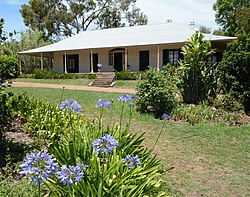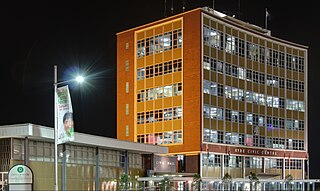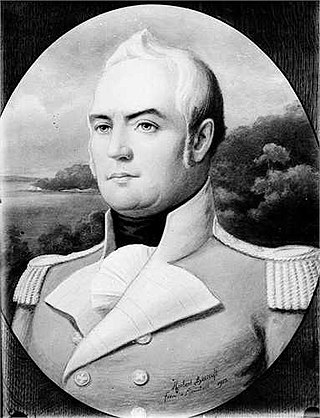History
In 1789, James Ruse was chosen by Governor Arthur Phillip to run an experiment to see how long it would take a man to support himself. Ruse was granted 0.61 hectares (1.5 acres) of cleared land, as well as assistance for clearing an additional 2.0 hectares (5 acres). He was also provided with two sows and six hens. He was fed and clothed from the public store for 15 months, after which time he had become successfully self-sufficient and was granted an additional 12 hectares (30 acres). [3]
In October 1793, Ruse sold his farm to surgeon John Harris, builder of the substantial colonial cottage which exists today. [4] Harris already owned the adjacent property. At the time Harris had many varied roles in the colony, including Magistrate, Deputy Judge Advocate, Superintendent of Police and Naval Officer. He went on to become one of the wealthiest pastoralists in the colony, owning extensive properties in New South Wales. [5] [1]
Harris, born in County Londonderry, Ireland, spent at least ten years in the Navy as a surgeon's mate, and sailed in New South Wales in his own 21 foot wherry. He was a soldier when serving as an officer in the New South Wales Corps. In the roles of judge advocate and magistrate he functioned as a lawyer. As a public servant in the early 1800s and again in the mid-1820s he was head policeman: as a naval port officer he was a tax man and a government spy. As a builder occasionally contracted by government he constructed the road to South Head in 1803 and public buildings including a toll house in Parramatta in 1829. Displaying the skills of an architect and design engineer he oversaw construction of the 59 ton government schooner, "Integrity", the Sydney Court House and his own substantial dwellings at Parramatta, Ultimo and South Creek. He was a farmer and a grazier; an explorer who participated in several expeditions including that of Colonel William Paterson to the Hunter in 1803 and Surveyor John Oxley's 1818 expedition to the interior; a mercantile agent; and a banker, being one of the founding directors of the Bank of New South Wales - the colony's first bank. A busy many, he played many of these roles while serving as a surgeon to the New South Wales Corps. While never a pauper, when he served as a surgeon's third mate in the Royal Navy in India during the 1770s and 1780s he was not affluent. Yet, by the early 1800s he was a rich man. In 1804 he constructed the first two storeyed verandahed house in the colony (Ultimo House) and had imported deer from India as hunt quarry. In 1814 he gave architect Francis Greenway his first private commission. [6] [1]
The cottage is in the form of the Indian Bungalow, a verandahed form Harris saw in Bengal, India from his arrival in 1782, that was used to house English officers on service there. The cottage's form originated in Bengal, which was the first region the British moved from coastal forts to occupy the interior. Such Anglo-Indian dwellings were primarily used as residence or a place for both living and working, with an office incorporated into the plan. Their builders used traditional Indian strategies to respond to climatic conditions, maximising ventilation and shade and protection from heavy rain while meeting European expectations of form and comfort. It emerged as a "culturally distinctive house form", the typical "up-country" dwelling for British officials. This form had its attractions for Harris in New South Wales when he not only attended outpatients but occasionally accommodated the very ill at his home. The hot summers and cool winters of Sydney had more in common with Bengal than Moneymore. The tightly closed houses of Ireland, designated to minimise draughts, were not appropriate in India or New South Wales. The bungalow as adopted by the British was characterised by a pitched thatched roof, a verandah and a raised base platform. It was a free-standing single storey structure. The verandah was sometimes adapted by the British to encircle the house with parts semi-enclosed for privacy and shade. With the possible exception of the thatching, these essential qualities are also characteristics of Experiment Farm Cottage, constructed in the mid-1790s at Parramatta by Harris. [7] Dr Wilson's bungalow house at Moidapur bears striking similarities with Harris' Experiment Farm Cottage. Both have a verandah integrated into the roof, both are built on a platform, both have shutters, and both have part of the verandah partially enclosed. Both men were in Bengal in the early 1780s. [8] [1]
The property stayed in the Harris family until 1921, when the land was subdivided and the suburb of Harris Park was created. [5] [1]
The site was acquired by the National Trust of Australia (NSW) in 1961, after the establishment of the Women's Committee including women such as Dame Helen Blaxland and Rachel Roxburgh, which raised the necessary funds of 4,500 pounds. This committee was established to raise funds, source furnishings and promote Trust membership. Experiment Farm Cottage was the first property the National Trust (NSW) acquired and the Trust restored and furnished the cottage with colonial pieces and opened it to the public. Ms Roxburgh wrote the first guide books for the property for the Trust. [1]
In 1960 Cherry Jackaman joined Dame Helen Blaxland on the Women's Committee of the National Trust (NSW). Jackaman chaired this committee from 1964–67 and by 1968 had raised more than $100,000, which was directed to repairs work at Experiment Farm Cottage, Lindesay and the St. Matthews Anglican Church at Windsor Appeal. [1]
In 1963 the cottage was opened by the National Trust (NSW) as Australia's first house museum with a focus on Australian colonial furniture. [5] [1]
In 1967 the National Trust reconstituted the Lindesay Garden Group as the National Trust Garden Committee, with Diana Pockley as chair. This Committee's work was broader, including work on replanting the grounds of Experiment Farm Cottage, Parramatta, Old Government House, Parramatta and Riversdale, Goulburn. [1]
A Parramatta Properties Committee was established to advise and guide works, dating (at least) from 1968, and chaired from 1971-2 by Dame Helen Blaxland. This committee was disbanded in 1984. [1]
Since acquisition, Federal and State Government funds have been made available to also purchase adjoining blocks of land/ houses and demolish these, helping to create a more credible landscape setting for what was John Harris' simple farm cottage complex. Centenary of Federation funds from the Federal Government allowed implementation of a reinstated simple farm garden based on evidence of early - mid 19th century garden plantings around the cottage, including appropriate farm fencing, reinstated plantings such as giant Danubian reed ( Arundo donax ) on the north-east corner of the cottage, and a bunya pine ( Araucaria bidwillii ) to its north. [1]
These same funds allowed the closure of Ruse Street to the west of the cottage, reinstatement of a narrowed carriage drive in front (north) of the cottage, and a new reduced width public road access east of the cottage connecting to Ruse Street (east), based on the location and form of a known earlier farm track. [9] [1]
In preparation for the 50th anniversary of the opening of the cottage as a house museum by the Trust, the cottage has undergone a much-needed restoration program of works, funded by the Dame Helen Blaxland Foundation and NSW State Heritage Grants. [5] It was reopened to the public in July 2013, with a celebration of the 50th anniversary of its first public opening, with NSW Governor and National Trust Patron Marie Bashir re-enacting the 1963 event. Visitation increased from 3581 in 2012/13 to 4557 in 2013/14. The caretaker's cottage was refurbished in 2014 making it suitable for rental accommodation, and work on the rear garden was carried out under the supervision of Colleen Morris, enhancing its appeal for events. [10] [1]
Description
Experiment Farm Cottage is an Old Colonial Georgian house with symmetrical front and low pitched hipped roof continuous over verandah of vertically seamed iron. The entrance consists of a six-panelled door flanked by sidelights and with an elliptical fanlight above. [1]
It sits in a small domestic garden with some mature trees, including jacaranda, (Jacaranda mimosaefolia), lemon scented gum ( Corymbia citriodora ), fruit trees and cottage plants. Since 2001 a more appropriate 19th century pleasure garden to the north has been reconstructed, based on early photographs and records, and comprising 2 large oval beds with mixed tree and shrub planting, a series of "framing" trees including a hoop pine (Araucaria cunninghamiana) and others. [1]
Ruse Street's eastern end is closed off from the west and now accessed by a new diversion local street, on the alignment of a known former farm track, immediately to the east of Experiment Farm Cottage. This road is finished as though it were a gravel farm track, and farm-style post and rail fencing abuts it, and Alice Street to the south. [1]
The remaining setting of Experiment Farm Cottage is of an early 1900s residential subdivision, of mostly single-storey California bungalow cottages, with some later infill of blocks of flats, dating from the 1960s, and some 1980s & 1990s single houses, some two storey. This is the last subdivision of the Harris Farm estate, and its boundary represents (roughly) the 12 hectares (30 acres) of land originally granted to James Ruse in 1788. [1]
Experiment Farm Cottage is fully professionally conserved. [1]
Modifications and dates
- 1788-93: James Ruse farms first land grant in Australia, experimental farm of 12 hectares (30 acres)
- 1793: Surgeon John Harris buys, incorporates into "Harris Farm", cultivates, and clears land
- c. 1834 Cottage constructed, in front of earlier cottage of 1809 [1]
- 1850s: railway extended to Parramatta to west of estate, start of subdivisions [1]
- 1920s: subdivision of Harris estate in stages to form modern suburb of Harris Park, Ruse Street formed north of EFC, Alice Street to south. Cottage's address to north blocked by cottages on northern side of Ruse Street
- 1950s: Parramatta City Council acquire Hambledon Cottage to east of reserve/site and convert to house museum (Parramatta & District Historical Society run it) [1]
- 1961: National Trust (NSW) acquire Cottage block for house museum after establishment of the Women's Committee including women such as Dame Helen Blaxland and Rachel Roxburgh, which raised the necessary funds of A£4,500. This was the first property the National Trust (NSW) acquired, and the Trust has since restored and furnished the cottage with colonial pieces and opened it to the public [1]
- 1967: the National Trust reconstituted the Lindesay Garden Group as the National Trust Garden Committee, with Diana Pockley as chair. This Committee's work was broader, including work on replanting the grounds of Experiment Farm Cottage, Parramatta, Old Government House, Parramatta and Riversdale, Goulburn [1]
- 1970-80s: Federal Government acquire a number of house lots adjoining EFC and demolished to improve the setting of EFC, ownership of lots transferred to Parramatta City Council as James Ruse Reserve. Acquisition/conversion links Hambledon & EFC. Federal and State Government funds have been made available to also purchase adjoining blocks of land/ houses and demolish these, helping to create a more credible rural landscape setting for what was John Harris' simple farm cottage complex. A Parramatta Properties Committee was established to advise and guide works, dating (at least) from 1968, and chaired from 1971-2 by Dame Helen Blaxland. This committee was disbanded in 1984 [1]
- 2001/2: Centenary of Federation funds from the Federal Government allowed implementation of a reinstated simple farm garden based on evidence of early - mid 19th century garden plantings around the cottage, including appropriate farm fencing, reinstated plantings such as giant Danubian reed (Arundo donax) on the north-east corner of the cottage, and a bunya pine (Araucaria bidwillii) to its north. During the 1970s & 1980s a number of residential allotments adjoining Experiment Farm Cottage were resumed by the Federal Government with the aim of improving the setting of the Cottage. The houses on these allotments were demolished and the ownership of the newly created open space area was transferred to Parramatta City Council, to become part of the James Ruse Reserve. The boundary of the reserve was extended up to Experiment Farm Cottage. Through the creation of the reserves around the cottage, continuous park area now extends from Hambledon Cottage and Hassall Street (in the north-east and north) south to Experiment Farm Cottage and Alice Street in the south [1]
- 2000-01: NSW National Trust undertook a landscape reconstruction of some of the immediate 19th century pleasure garden and carriage drive north of Experiment Farm Cottage. These works focussed on the lands around Ruse Street and south toward Alice Street. Ruse Street's eastern end was closed off and access redirected immediately to the east of Experiment Farm Cottage, along the alignment of a known former farm track. The new road was built to resemble a farm track, in finish, and fencing of a rural nature was installed on both sides of the new road. A carriage drive on the alignment of the original 19th century carriage drive replaced the former Ruse Street in front (north) of Experiment Farm Cottage. The remainder of the street surface and furniture (power poles, kerbs etc.) were removed or put underground and a pleasure garden based on early photographs and records was reconstructed. No. 14 Ruse Street was acquired by the Trust and demolished (1920s California bungalow), and its grounds incorporated into the reconstructed landscape of Experiment Farm Cottage, widening its views north and the public views south up the hill from Hassall Street/James Ruse Reserve [1]
- 2000-1: Parramatta City Council installed a new pedestrian footbridge over Clay Cliff Creek north of Experiment Farm Cottage to provide easy access as part of the Harris Park Heritage Walk, a series of works to install a pedestrian path, landscaping and interpretive signage along a series of heritage items including Hambledon Cottage and Experiment Farm Cottage [9] [1]
- 2013: The 2013 restorations helped stabilise emerging problems including underpinning the north-east corner, internal plastering and painting, new electrical circuitry and power upgrade and re-rendering the cellar. A new fire alarm system and upgraded security alarm system including video surveillance have been installed. The house's presentation front and back have been improved with front and back verandahs lifted, levelled and re-grouted, the exterior painted, the rear garden landscaped, several important collection items repaired and restored. The caretaker's cottage has also been fully refurbished and refitted for the first time since 1962, the volunteer office and kitchen given a new fitout [11] [1]


















